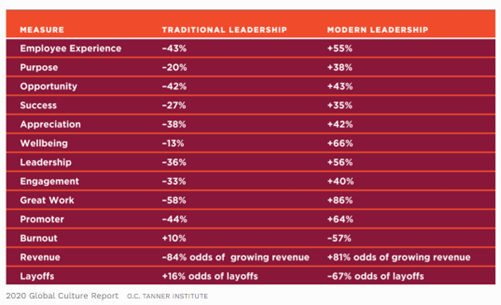.png?width=600&height=314&name=Resources%20Thumbnails%20(15).png)
For the first time in history, today’s leaders are leading four generations. This dynamic requires a different leadership style than the traditional style that most leaders were taught. The idea that there can only be one leader whom everyone must follow is no longer valid. The expanding range of demographics in the workplace requires a modern leadership style that is more inclusive and collaborative. Modern leadership has many rewards for people and organizations who are willing to challenge the traditional beliefs about leadership.
What is a modern leader?
A modern leader builds community within all layers of an organization. Alicia Chandler, president of Oak Street Funding, explains how she seeks to build community in the organization. “I feel it is important to spend time with employees, maybe over a cup of coffee, to learn everyone’s ideas and concerns.” Through these conversations, employees feel connected to their leadership. Intentional community building is a vital initiative for modern leaders to build inclusivity within organizations.
Modern leaders are dedicated to lifelong learning. Paul Leroue, Principal and CMO with WIPFLI and a 41-year leadership veteran says he is still in kindergarten when it comes to learning about leadership. He cautions leaders who feel they have their PhD in leadership that they are in danger of becoming stagnant. Leadership is a skill-based discipline that modern leaders must continually strive to improve in.
Lastly, modern leaders invest in developing leaders in all levels of the organization. They build a powerful vision and make space for everyone in the organization to be part of the vision. Instead of making decisions and forcing others to follow, modern leaders ask their employees, “What decision would you make?” This inclusive approach leads to better decision-making because more ideas are explored and employees are empowered to have a part in the vision of the organization.
There are four important characteristics of a compelling vision: future-oriented, includes a plan, involves people, and measurability.
- Future-oriented – What is the big picture? A compelling vision must show people where the organization is headed and why. The big picture acts as a road map for the vision and shows the destination.
- Includes a Plan – A vision without a plan is just a dream. The plan is necessary to make the vision a reality. Include SMART (Specific, Measurable, Achievable, Relevant, and Time-Bound) goals in the plan to break it down into digestible steps.
- Involves People – A vision will only compel people if they have a role in creating the vision. Seek input from employees when creating the vision and you will be more likely to have their buy-in. Achieving a vision requires the talents and ideas of a wide variety of people working together so it makes sense that they have a role in its creation.
- Measurability – What are the benchmarks you’re going to measure along the way to demonstrate progress toward fulfilling the vision? If you want people to be supportive of your vision, you need to show them milestones of progress and celebrate those milestones.
What are the benefits of modern leadership?
Research clearly shows modern leadership is absolutely necessary for employee retention and company growth. Data from researchers at the O.C. Turner Institute shows not only the benefits of modern leadership, but also the detrimental effects of traditional leadership.

Without modern leadership, businesses will see decreased employee engagement and revenue growth. In a traditional leadership model, there are many points of failure because the power is held by a few individuals and bottlenecking occurs. An organization that embraces modern leadership develops leaders at all levels and empowers employees. When employees are empowered, the culture improves, revenues will go up, and the organization will grow.
How does a leader become a modern leader?
The number one characteristic a leader must develop to become a modern leader is a willingness to learn. Modern leadership requires constant learning, growing, and evolving. “If you aren’t willing to learn, you are going to hit a threshold. No one likes to work for a leader who isn’t invested in learning,” warns Leroue. Learn from your employees as well as leadership experts. There are so many online resources for leaders to take advantage of without spending a lot of money. However, the best source of learning comes from within your own organization. As you spend time with your employees, you’ll learn their pain points and ideas for improvement. This will help you optimize operations and lead to greater growth.
The commitment to becoming a modern leader takes an investment of time. Ask yourself, “Am I willing to invest in becoming a better leader?” Then, create a plan to become a better leader by seeking opportunities to learn and grow. Your employees and organization will thank you for it.

Disclaimer: Please note, Oak Street Funding does not provide legal or tax advice. This blog is for informational purposes only. It is not a statement of fact or recommendation, does not constitute an offer for a loan, professional or legal or tax advice or legal opinion and should not be used as a substitute for obtaining valuation services or professional, legal or tax advice.


.png?width=600&height=314&name=Resources%20Thumbnails%20(15).png)


/Resources%20Thumbnails%20(47).png)

/Resources%20Thumbnails%20(20).png)